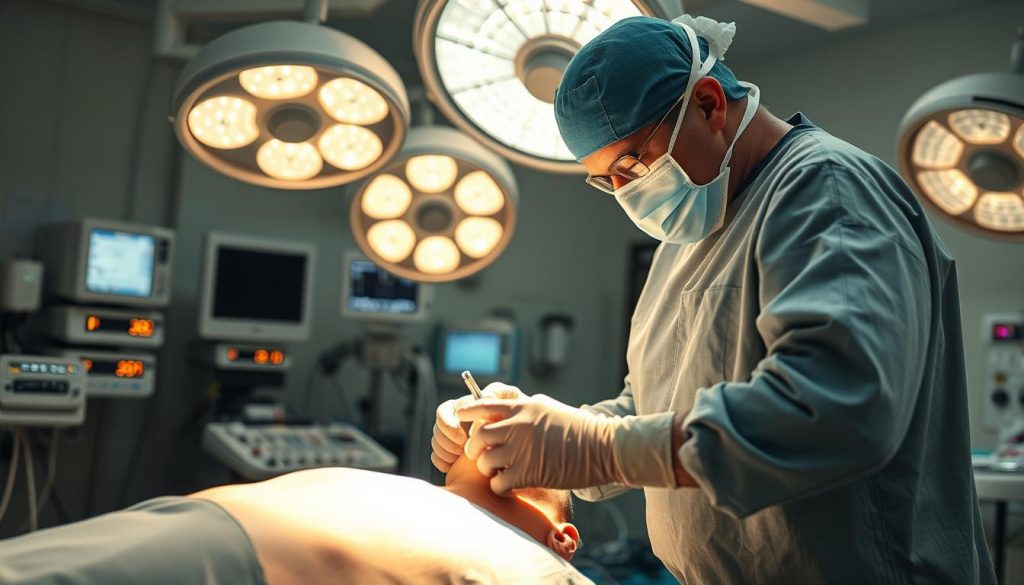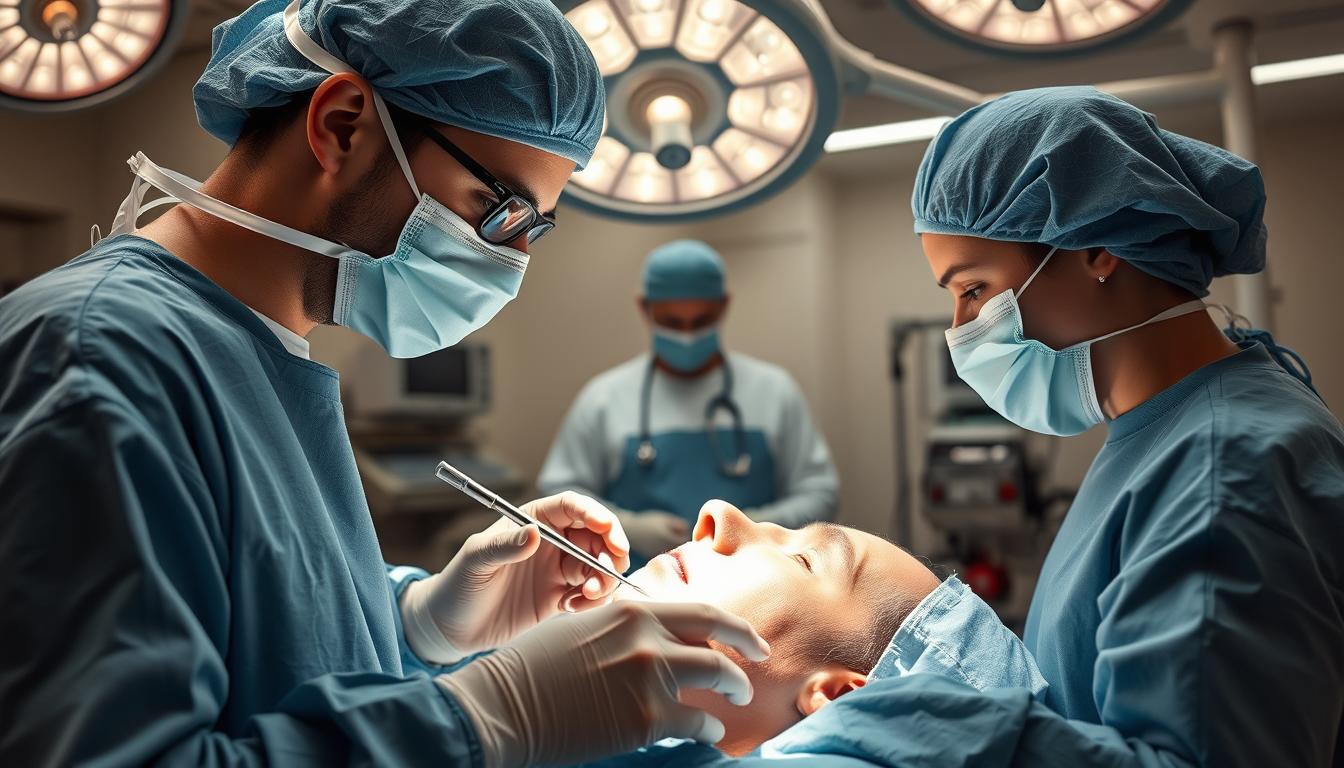Reconstructive surgeons play a vital role in healthcare, performing surgical procedures to restore function and appearance to body parts affected by birth defects, trauma, disease, or cancer treatment.
These highly trained specialists work to enhance patients’ lives by addressing both physical functionality and aesthetic concerns through advanced surgical techniques. Our surgeons push the boundaries of science through ongoing research, delivering new treatment options for patients and elevating standards of care.
Key Takeaways
- Reconstructive surgeons restore function and appearance to affected body parts.
- Advanced surgical techniques address physical and aesthetic concerns.
- Ongoing research delivers new treatment options and elevates care standards.
- Reconstructive surgery encompasses a wide range of procedures.
- Specialized training and fellowships enhance surgeons’ expertise.
Understanding the Role of Reconstructive Surgeons
Reconstructive surgeons play a vital role in restoring form and function to individuals affected by injury, disease, or congenital conditions. They are highly trained medical experts who specialize in performing complex surgical procedures to improve patients’ quality of life.

Our team of highly trained plastic surgeons covers the entire spectrum of plastic surgery, including reconstructive surgery. The key difference between reconstructive and cosmetic surgery lies in their objectives: while cosmetic surgery focuses on enhancing appearance, reconstructive surgery aims to restore function and appearance to damaged or deformed areas.
Difference Between Reconstructive and Cosmetic Surgery
Reconstructive surgery is performed to correct defects or injuries, whereas cosmetic surgery is elective and aimed at improving aesthetics. Reconstructive plastic surgery can significantly improve a patient’s quality of life by restoring normal function and appearance.
Training and Specializations
Reconstructive surgeons undergo rigorous training, including medical school, a general surgery residency, and a plastic surgery fellowship. Many also pursue additional specialized training in areas like hand surgery, burn reconstruction, and microsurgery at a medical center. Some key aspects of their training include:
- Completing a comprehensive educational path that includes medical school and residencies.
- Pursuing fellowship training in subspecialties like craniofacial surgery and microsurgery.
- Obtaining board certification through the American Board of Plastic Surgery.
Common Reconstructive Procedures
Reconstructive surgeons employ a variety of advanced surgical techniques to restore form and function to areas of the body affected by injury, disease, or congenital conditions.

Breast Reconstruction After Cancer
Breast reconstruction after cancer is a complex process that involves restoring the breast to its natural appearance after mastectomy or lumpectomy. Reconstructive surgeons use various techniques, including implant-based reconstruction and autologous tissue transfer, to achieve optimal results.
Craniofacial Surgery
Craniofacial surgery addresses congenital or traumatic deformities of the skull and face. These delicate procedures require precise planning and execution to restore normal anatomy and function, significantly improving the patient’s quality of life.
Hand and Extremity Reconstruction
Hand and extremity reconstruction involves reconstructive surgery to repair damaged hands and limbs. This can include microsurgical techniques to restore sensation and movement, as well as various reconstructive options like nerve transfers and tendon grafts to enhance functionality.
Advanced treatments for conditions such as Raynaud’s phenomenon and peripheral nerve injuries can significantly improve patient outcomes.
Advanced Techniques Used by Reconstructive Surgeons
Advanced reconstructive techniques are revolutionizing the way surgeons approach complex cases. These innovations are enhancing patient outcomes and expanding the possibilities of reconstructive surgery.

Microsurgery and Tissue Transfer
Microsurgery and tissue transfer are critical components of modern reconstructive surgery. These techniques enable surgeons to repair damaged tissues and restore function with greater precision.
3D Printing and Computerized Surgical Planning
The integration of 3D printing and computerized surgical planning has significantly improved the accuracy of reconstructive procedures. These technologies allow for precise preoperative planning and the creation of customized implants and prosthetics.
Innovative Approaches to Scar Treatment
Reconstructive surgeons now employ a range of innovative approaches to scar treatment, including laser therapy, scar revision, and advanced topical treatments. These methods aim to minimize scarring and improve the appearance and functionality of affected skin.
Some of the leading-edge reconstructive surgeries include laser treatment of hypertrophic scars, scar revision, and laser-assisted scar resurfacing. Modern scar treatment encompasses a spectrum of approaches, from non-invasive therapies to surgical revision, tailored to each patient’s specific conditions and needs.
The Reconstructive Surgery Process
Understanding the reconstructive surgery process is crucial for patients to make informed decisions about their care. This process involves several key stages that ensure the best possible outcomes.
Initial Consultation and Evaluation
The journey begins with an initial consultation where the surgeon evaluates the patient’s needs and discusses potential procedures. This stage is critical for setting expectations and planning the surgery.
Preparing for Reconstructive Surgery
Before undergoing reconstructive surgery, patients receive guidance on how to prepare, including information about breast care if applicable, and other services that may be required. Proper preparation is key to a smooth surgery experience.
Recovery and Follow-up Care
After the procedure, patients are monitored as the anesthesia wears off. Care during the recovery phase is crucial, with a focus on pain management and follow-up appointments to ensure proper healing. A table summarizing the recovery process is provided below.
| Stage | Description | Care Requirements |
|---|---|---|
| Immediate Post-Surgery | Monitoring as anesthesia wears off | Pain management, rest |
| Short-Term Recovery | Healing of surgical sites | Wound care, follow-up appointments |
| Long-Term Recovery | Full recovery and rehabilitation | Physical therapy, emotional support |

Leading Reconstructive Surgery Centers in the US
The US boasts some of the world’s most renowned reconstructive surgery centers, offering patients access to top-tier care and innovative treatments.

Johns Hopkins Department of Plastic and Reconstructive Surgery
Johns Hopkins is a leader in reconstructive surgery, with a team of experts in plastic reconstructive surgery. Their comprehensive program includes treatments for cancer and trauma, as well as breast reconstruction.
University of Chicago Medicine Plastic Surgery
The University of Chicago Medicine Plastic Surgery program is distinguished by its comprehensive approach to reconstructive surgery. Their team of specialists covers the full spectrum of procedures, from head and neck reconstruction to gender-affirming surgeries.
The center’s expertise includes:
- Post-cancer reconstruction, particularly breast reconstruction following mastectomy and head and neck reconstruction after tumor removal.
- Cutting-edge treatments for facial trauma and congenital craniofacial differences.
- A multidisciplinary approach ensuring coordinated care from teams that may include oncologists, orthopedic surgeons, neurosurgeons, and rehabilitation specialists.
Finding the Right Reconstructive Surgeon for Your Needs
The process of choosing a reconstructive surgeon involves careful consideration of several key factors. Verifying credentials is the first step, ensuring that the surgeon is board-certified in plastic surgery and has additional fellowship training in relevant subspecialties.
Patients should research the surgeon’s experience with their specific reconstructive needs, whether it’s breast reconstruction after cancer treatment or facial trauma repair. Consulting with multiple plastic surgeons allows patients to compare approaches and communication styles.
The surgeon-patient relationship is crucial in reconstructive surgery, which often involves multiple procedures. Patients should review before-and-after photos, consider geographical factors, and inquire about the qualifications of the entire surgical team, including anesthesiologists and nursing staff.
By carefully evaluating these factors, patients can make an informed decision when selecting a reconstructive surgeon, ultimately achieving the best possible outcome for their specific needs.
FAQ
What is the difference between plastic surgery and reconstructive surgery?
Plastic surgery is a broad term that encompasses both cosmetic and reconstructive procedures. Reconstructive surgery, on the other hand, focuses on restoring form and function to damaged or deformed tissues and body parts, often due to trauma, cancer, or congenital conditions.
What are some common conditions treated by reconstructive surgeons?
Reconstructive surgeons treat a variety of conditions, including breast cancer, cleft lip and palate, hand trauma, and facial deformities. They also address skin and tissue damage resulting from burns, accidents, or other traumatic events.
What techniques do reconstructive surgeons use to achieve optimal results?
Reconstructive surgeons employ advanced techniques, such as microsurgery, tissue transfer, and 3D printing, to restore function and appearance. They also utilize innovative approaches to scar treatment, minimizing visible scarring and promoting optimal healing.
How do I prepare for reconstructive surgery?
Preparation for reconstructive surgery involves an initial consultation and evaluation with a qualified reconstructive surgeon. Patients should discuss their medical history, treatment goals, and any concerns with their surgeon to ensure a smooth and successful procedure.
What can I expect during the recovery process after reconstructive surgery?
The recovery process varies depending on the type and complexity of the procedure. Generally, patients can expect some discomfort, swelling, and bruising, which can be managed with medication and follow-up care. A reconstructive surgeon will provide personalized guidance and support throughout the recovery process.
How do I find a qualified reconstructive surgeon?
To find a qualified reconstructive surgeon, patients can research leading reconstructive surgery centers, such as those at Johns Hopkins or the University of Chicago Medicine. They can also ask for referrals from their primary care physician or other healthcare professionals.
